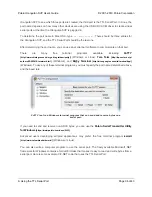
PuTTY is a free Windows terminal program that can send and receive bytes on a
serial port.
If you need to send and receive non-ASCII bytes, you can use the
Pololu Serial Transmitter Utility
for Windows
[https://www.pololu.com/docs/0J23]
.
Advanced users developing scripted applications may prefer the free terminal program
kermit
[http://www.columbia.edu/kermit/]
(Windows or Linux).
You can also write a computer program to use the serial port. The freely available Microsoft .NET
framework for Windows contains a
SerialPort
class that makes it easy to read and write bytes from a
serial port. Here is some example C# .NET code that uses the USB Communication Port:
1
2
3
4
5
6
7
8
9
10
11
12
13
14
15
16
17
18
19
20
21
22
23
24
25
// Choose the port name and baud rate.
//
Port Name must be determined from the Device Manager.
//
Baud rate is irrelevant for the USB Communication Port.
System.IO.Ports.SerialPort port =
new
System.IO.Ports.SerialPort(
"COM4"
, 115200);
// Connect to the port.
port.Open();
// Set the DTR line to 1.
port.DtrEnable =
true
;
// Transmit two bytes to the AVR: 0x61, 0x62
port.Write(
new
byte[]{0x61, 0x62}, 0, 2);
// Wait for a byte to be received on the RX line.
int
response = port.ReadByte();
// Show the user what byte was received.
MessageBox.Show(
"Received byte: "
+ response);
// Set the DTR line to 0.
port.DtrEnable =
false
;
// Disconnect from the port so that other programs can use it.
port.Close();
?
Pololu Orangutan SVP User’s Guide
© 2001–2019 Pololu Corporation
8. Using the USB Communication Port
Page 33 of 43











































